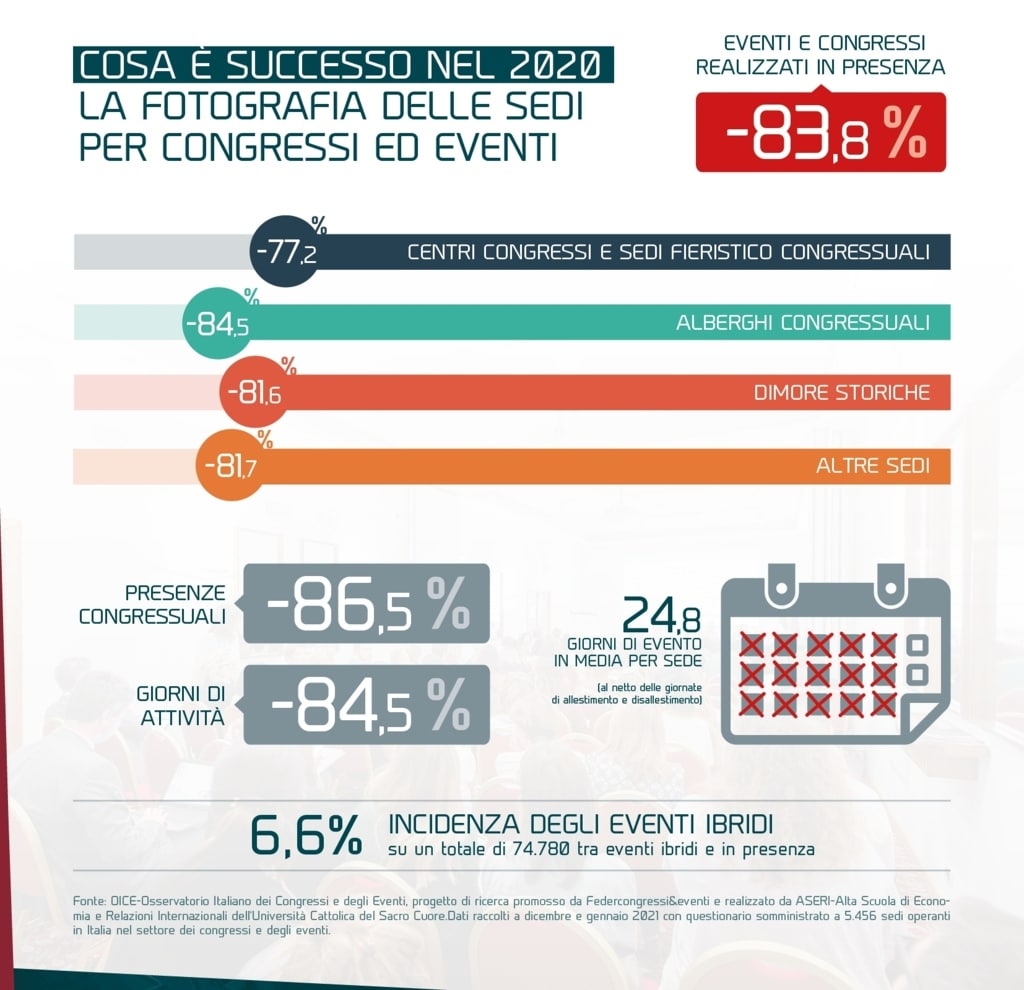The Italian Survey of Conferences and Events [Osservatorio Italiano dei Congressi e degli Eventi–OICE]shows a dramatic slump in revenues for conference and events venues
The crisis sparked by the Covid-19 emergency has had a devastating impact on the conference and events industry. According to the Italian Survey of Conferences and Events, events venues registered a decline in revenues of 79% in 2020.
Conference centres, trade fair conference venues, hotels, historic residences and other types of events venue have thus been the hardest hit companies in the tourism value chain. Based on Istat findings, revenues for 2019 fell by 37.2% for catering services, 54.9% for accommodation services, 60.5% for aviation and 76.3% for travel agents and tour operators.
The conference and events market in Italy in 2020
The decline in revenues registered by venues is the most obvious consequence of the drastic reduction in activity that has hit the whole meetings industry.The study, promoted by Federcongressi&eventi, the national association representing the sector, and conducted by ASERI–the Graduate School of Economics and International Relations of Università Cattolica del Sacro Cuore, highlights a series of indicators, all preceded by a minus sign.
According to the research study that has monitored events and conferences held in Italy since 2014, 69,880 events were held in person in 2020, a huge 83.8% drop from 2019. Attendance figures and venues’ days of activity also followed a negative trend. Attendance came in at 5,847,330 (-86.5%), while days of activity excluding set-up and dismantling, totalled 95,020 (-84.5%), equivalent to 24.8 average net days of events per active venue. Almost 30% of events did not host any event.
The crisis hit all types of venues and all geographical regions of the country in the same way, with the Islands registering the highest decrease in events hosted, at -90.5%.
Hybrid events: an opportunity but not a solution
To respond to the succession of restrictions on in-person events, venues promptly invested in technology enabling them to host hybrid events, i.e. those that could receive a restricted number of people physically at the venue, with an audience following proceedings remotely. This was a necessary decision, but one that did nothing for the other players in the meetings industry value chain (hotels, caterers, fitters, transport companies, etc.).
Based on the sample of respondents to the OICE, 42% of venues held one or more hybrid events: the venues that hosted the most events of this type (67%) were conference centres and trade fair conference venues.
Scaling the data collected up to the entire sector, we can suppose thataround 4,900 hybrid events were held last year, equivalent to 6.6% of the total 74,780 in-person and hybrid events held.
The outlook: when will the industry be fully operational again?
Expectations regarding reopening dates have already been largely disappointed: 67% of the venues contacted between December 2020 and January 2021 expected that they could again host conferences and events by the end of the first half of 2021.Of these, 17.8% hoped to reopen in the first quarter.
As regards assumptions concerning a return to the levels of events hosted pre-Covid-19, the majority, 63.8%, estimated it would take 1-2 years and 26.8% 3-4 years.

“The serious crisis in the sector, confirmed by OICE data, will soon also be reflected in the financial statements of all the companies involved in the conference and events value chain, and not just those of the venues. After over a year of closures and inadequate support, the government must as a matter of urgency define the criteria for the measures that have been envisaged up to now, set up a dedicated fund for the industry for 2021 and plan the recovery for a sector that generates significant economic activity for the regions”, commented Federcongressi&eventi President Alessandra Albarelli.







No comment yet, add your voice below!